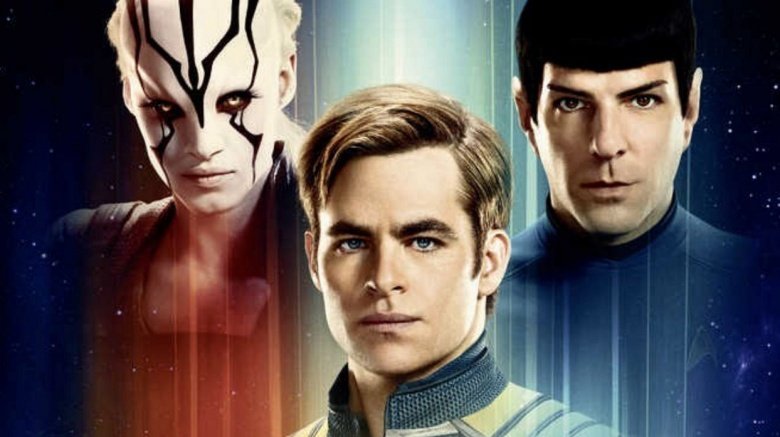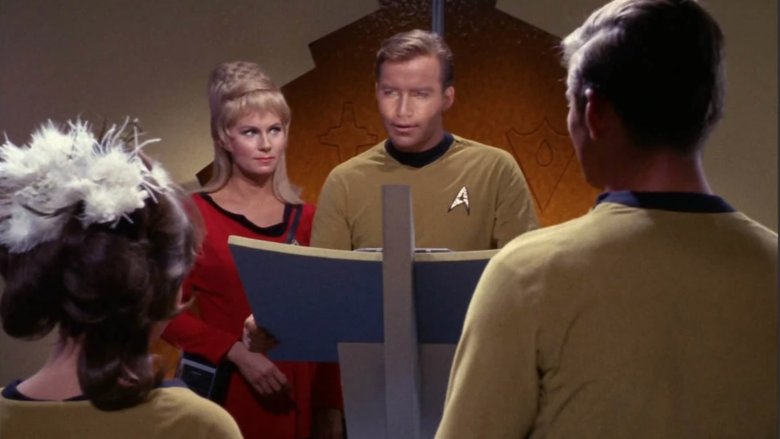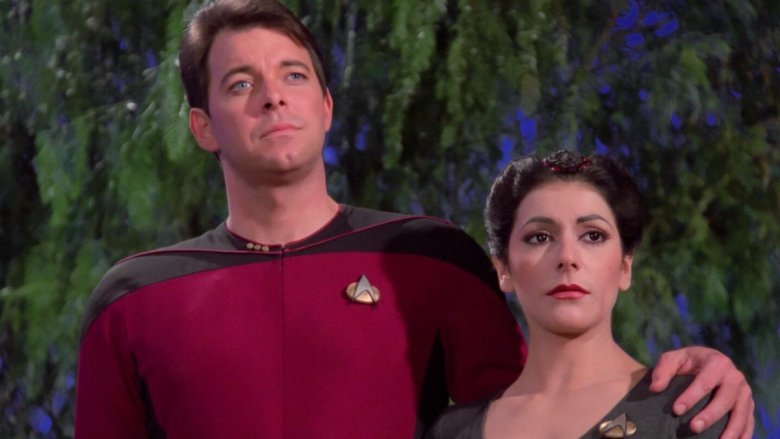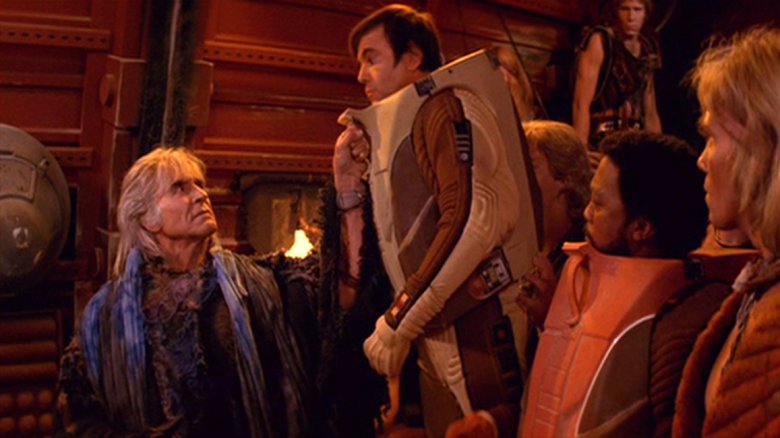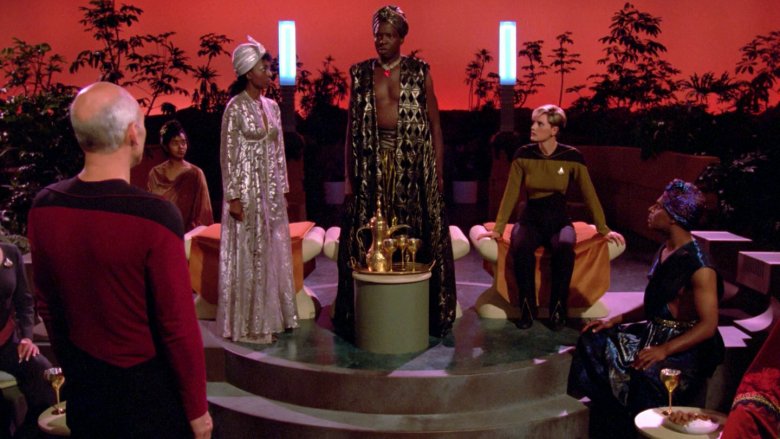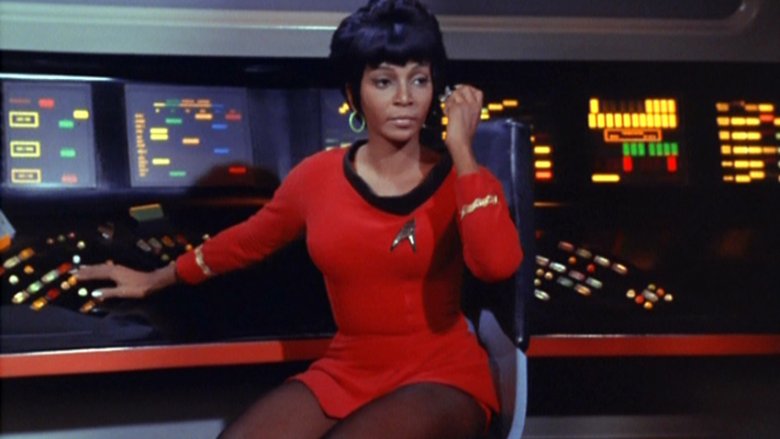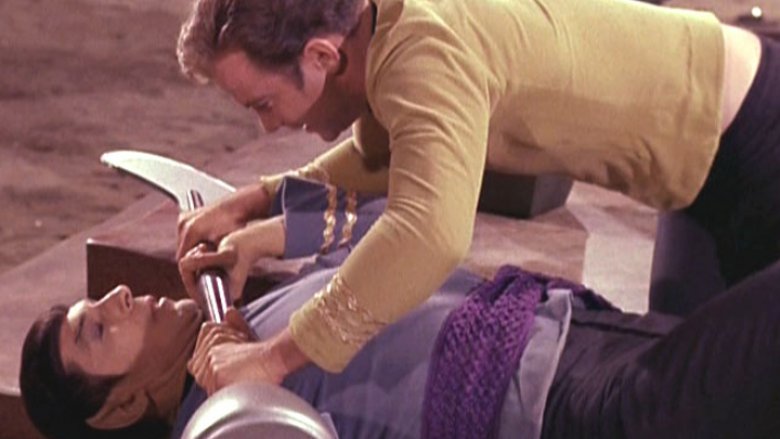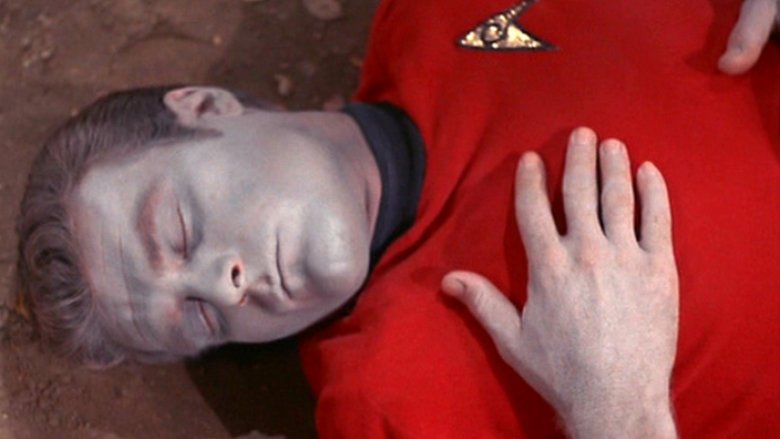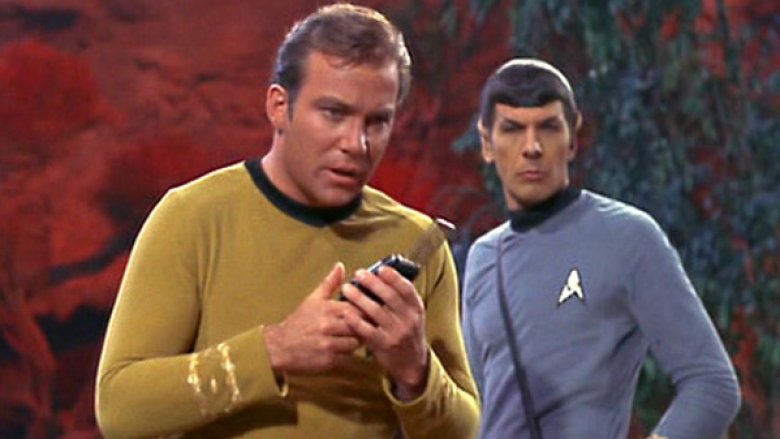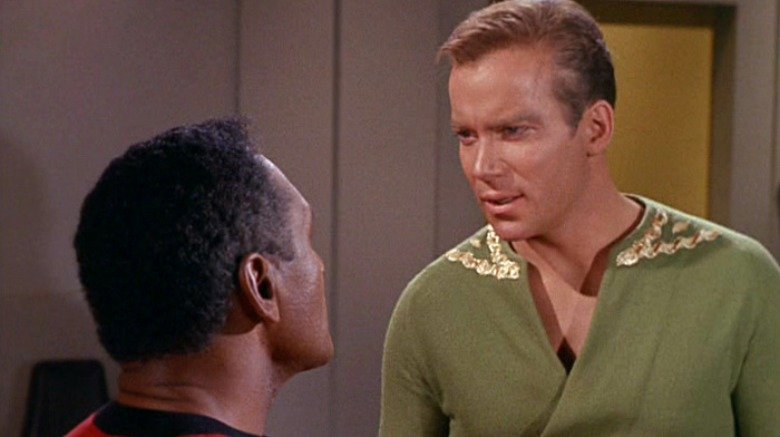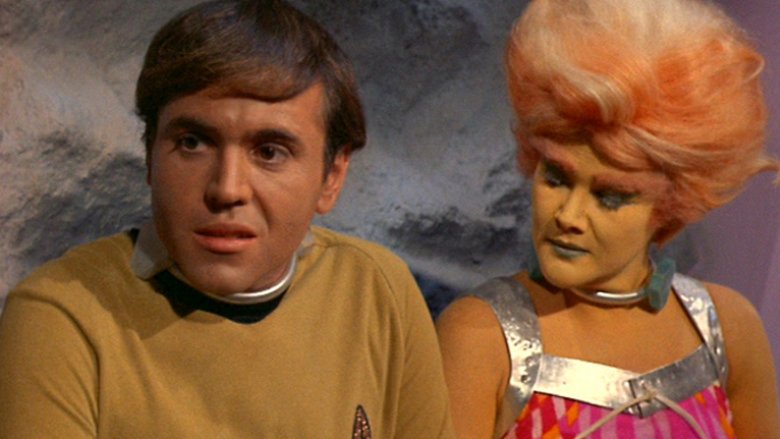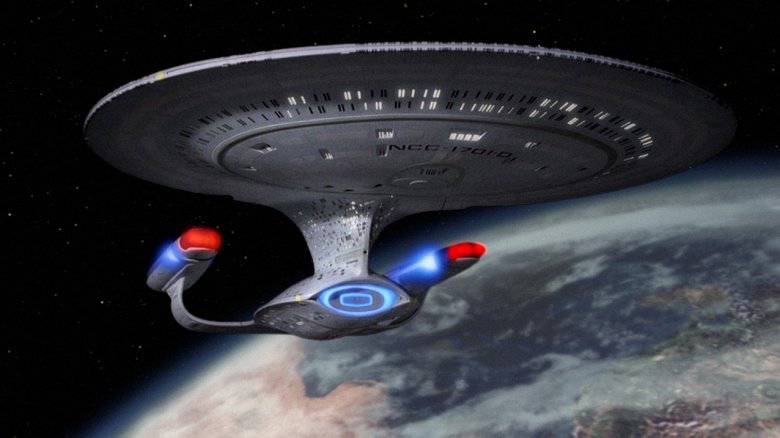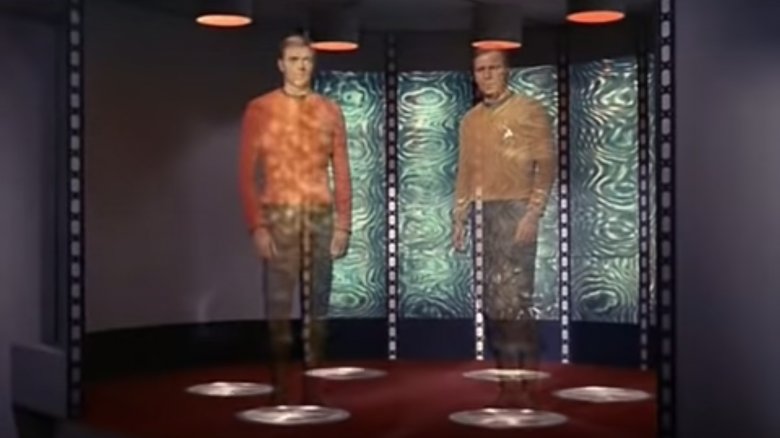False Facts About Star Trek You Always Thought Were True
As a Star Trek fan, you know a thing or two about the long-running franchise already. Sure, most folks can name Spock and Picard, but you know how often Vulcans procreate. Every seven years, for those keeping score. But, would you believe that some of your long-held assumptions are wrong? From famous phrases no one ever uttered to lies these shows deliberately tell, there are as many misconceptions about Trek as there are stars in the sky. When you've survived and thrived for over 50 years, it's only natural to have a few urban legends pop up along the way. Thankfully, much like a sex-starved Vulcan, we cannot tell a lie. So buckle up because we're about to go where no man ... er ... no one has gone before, into a nitpicky internet fight with a bunch of Trekkies. Here are things even die-hard fans get wrong about Star Trek.
Humans evolved beyond religion in Trek's Future
During Star Trek: Discovery's first season, a minor scandal broke out when actor Jason Isaacs admitted he was told not to ad-lib the phrase "god damn it," not because of the profanity, but because it included the word "god." Star Trek has long promoted a humanist and not-religious view of the future, with spirituality often left to the aliens. Trek producer Brannon Braga once said that creator Gene Roddenberry "made it well-known to writers ... that religion and superstition and mystical thinking were not to be part of his universe. On Roddenberry's future Earth, everyone is an atheist. And that world is the better for it."
But while Picard wasn't walking around with a giant crucifix around his neck, human religion has been a bit more present than is popularly thought. From the Enterprise's chapel, which appeared on The Original Series episode "Balance of Terror," to the hallucinatory Christmas celebration in the movie Star Trek: Generations, Christianity certainly seems to have survived to the 23rd century. Whether it was Uhura giving a little shout-out to Christ in the episode "Bread and Circuses" or the Voyager being turned into a Christmas ornament, Jesus got a lot of love from the supposedly atheist show. Kirk even states at one point that "mankind has no need for gods. We find the one quite adequate." Okay then, Father Kirk, see you at confession.
TNG characters were created for the show
Most Star Trek fans think The Next Generation started from scratch, creating a collection of new characters completely removed from the classic series. And, yes, many of the characters on TNG were new, including the bald, British captain and the hulking Klingon with a love of prune juice. But there were a few key characters with less original roots, thrown together with discarded parts from previous projects.
Before Star Trek made its way to the big screen, there was thought of bringing it back to television. Tests were even shot in 1977 for the project, called Star Trek: Phase II. Sets were built. Actors cast. Scripts written. But when the bigwigs decided it would work better as a feature film, the project was scrapped. Well, repurposed. In fact, a couple of the characters would show up in Star Trek: The Motion Picture, including the debonair Commander Decker and his former love, the exotic alien Ilia. But when those characters were jettisoned from future movies, the creatives decided to tweak them again for the small screen. That's how former lovers Decker and Ilia got reimagined as Commander Riker and Counselor Troi, with the same backstory and same personalities. Heck, a few of the Phase II scripts were even used during the 1988 writers' strike.
Khan couldn't know Chekov
Star Trek II: The Wrath of Khan is generally considered the best Trek movie. It's got a great villain, a heroic death, and a script not by William Shatner. Still, it isn't perfect, if only for one seemingly obvious mistake. When Khan Noonien Singh, the franchise's famous baddie, encounters Pavel Chekov on the desolate planet of Ceti Alpha V, he instantly recognizes the Enterprise's former ensign, saying he never forgets a face. There's just one problem. When Khan appeared on The Original Series, in the episode "Space Seed," Chekov hadn't yet joined the cast. So what gives with this seemingly glaring error? Trek fans are known for their obsessive knowledge of even the most arcane details about the show, so how could they include one so obviously wrong?
Well, the answer may be found in the most unlikely of places. The Season 2 episode "Catspaw" takes place at an earlier stardate than the one featured in "Space Speed," with Chekov playing a key role. It's entirely possible this was just a slip-up in the writers' room, but it provides a bit of evidence that Chekov was around when Khan was on the ship, hiding around corners and under space tables. Or you know, it was just sloppy writing, something Trek has had from time to time.
Trek always promoted equality
Star Trek has always tried its hardest to promote equality. Heck, Martin Luther King Jr. was a fan, so they're clearly doing something right. But although Trek often proclaimed good intentions, implementing them was another matter. In fact, right from the start, the show's lofty ideals ran into the reality of real-world bigotry. That was how the show's unaired pilot, which saw a woman serving as the Enterprise's first officer, also saw the captain complain, "I just can't get used to having a woman on the bridge." Or there's the infamous TNG episode "Code of Honor," which managed to be both racist and sexist at the same time, telling the story of an alien race that "speak in thick African accents, dress in stereotypical tribal garb, and are ruled by sexual appetites like ancient barbarians." In fact, the director of the episode was fired halfway through for his uncomfortably racist choices.
And then there's the long, drawn-out debate about including LGBTQ characters in the Trek universe. Roddenberry himself admitted that he had backward beliefs about homosexuality early in his life. By the time TNG rolled around, he was ready to introduce a gay character but died before he got the chance. Trek writer Ronald D. Moore has been candid about the franchise's handling of the topic, saying, "we've just failed at it." Thankfully, Discovery has finally included a gay couple as key members of the ship's crew, helping to fix a taboo that's long vexed the franchise.
Women always wore skirts in Original Series
If there's one iconic image from The Original Series, it's the miniskirt. It may not have been the most practical uniform for a space-faring Federation crewwoman, but it certainly was the most memorable. And yet, while that slight skirt has burrowed its way into our pop culture's collective unconscious, there were a handful of women who got to wear some actual slacks on the series.
In fact, the first two pilots produced, "The Cage" (later repurposed into the episode "The Menagerie") and "Where No Man Has Gone Before," both included women who got to actually cover up a bit. It was the network brass who made the suggestion to sex up the costumes because they weren't sure anyone would actually watch this weird outer space show otherwise. Grace Lee Whitney, who played Yeoman Rand on the show, was looking to show a little leg and suggested the miniskirt look. The rest was history — or the future, depending how you look at it. William Shatner actually remarked happily at the time that the show, "to the appreciation of all the men on the set, in fact all around the world, would boast the shortest skirts on women of any regular series on television." Suffice it to say, the viewers came, for the skirts and a whole lot else.
There was no conflict between characters
Gene Roddenberry, the visionary behind all things Star Trek, had a very specific edict for the characters on his shows. He was creating a utopian future in which humans will have achieved peace and conflict will be a thing of the past. An admirable goal for humanity, sure, but for a room of TV writers it was a living nightmare. How do you write drama without conflict?
Well, it turns out you can't. While the conflict-free decree did allow for a more allegorical storytelling style, something the franchise has always been famous for, the writers still managed to sneak in a fight here and there. Why else do you think the crew got possessed by alien gods and mating hormones so often? As long as the personal beefs were the result of some "external possession," Roddenberry would look the other way. And when he passed away in 1991, the writers behind the many Star Trek series began to loosen the reins. Deep Space Nine was rife with internal conflict, and a group of former terrorists allowed the main ensemble of Voyager the flexibility to create conflict on a weekly basis. By the time Discovery rolled around, the crew members were at each other's throats. From a deceitful captain to a key character leading a mutiny, the famous no-conflict rule quickly became a relic of the past, if it was ever truly followed to begin with.
Redshirts always die
On The Original Series, if you wore a red shirt, you were going to die. The crew was always beaming down to some god-forsaken planet, only to watch your hapless, no-name crimson-cloaked self get eaten by an alien blob or a malfunctioning robot. They were the cannon fodder of the Star Trek universe, just anonymous enough to make us feel bad without their deaths really mattering.
But would it surprise you to learn that these cardinal-hued crewmen weren't the most likely to die? While it's true that the redshirts did represent 73 percent of the total deaths over the series' three-year span, when you dig into the numbers something surprising pops out. There were 430 crewmen aboard the Enterprise, 239 of them dressed in red. According to Significance Magazine, even though "redshirts suffer many more casualties than crew members in other uniforms, they suffer fewer casualties than crew members in gold uniforms when the entire population size is considered. Only 10 percent of the entire redshirt population was lost during the three-year run of Star Trek. This is less than the 13.4 percent of goldshirts." So, if you're looking to make it through that five-year mission unscathed, slapping on a red uni might actually be your best bet by the numbers.
The inventor of the cellphone was inspired by Star Trek
When the flip phone first started popping up around the year 2000, Leonard Nimoy was a fan. And yet, he somehow didn't connect the dots between his new, high-tech toy and a device he'd been using for decades. As he joked with a fan, "You know, when I first got this thing ... I was sitting at a stoplight one day and all these people were pointing and laughing, and I realized the great irony of it all." It was a dead ringer for the Star Trek communicator he'd used countless times.
In fact, for a number of years, many fans thought the cellphone itself was based on that communicator, thanks to its inventor, engineer Marty Cooper. He developed the technology as part of Motorola and famously claimed his inspiration was the '60s space-faring series. But it turns out he may have gotten a little confused about his own invention. Years later, he said it was actually Dick Tracy and his wristwatch communicator that provided the idea for the device, and that pressure to perform for the documentary How William Shatner Changed The World led him to make up a story that wasn't true.
Kirk's uniform was gold
Any fan of The Original Series knows that Spock wore blue, Scotty wore red, and Kirk wore gold. Those colors are as indelibly linked to their characters as Spock's Vulcan salute and Shatner's hammy acting. So sit down because this may come as a bit of a shock. Kirk's uniform was, in fact, actually more of a lime green. It only turned into command gold thanks to the quirks of film stock development.
If you don't believe us, take a look at the rest of Kirk's wardrobe, like his wrap-around tunic from the "Trouble With Tribbles" episode, or his dress uniform in the Season 1 episode "Court Martial" (above). All green! That's right, decades before the internet freaked out about whether some random dress was black-blue or white-gold, Kirk was modeling the original color confounder. Apparently, many of the colors chosen for the show were intended to promote RCA's new color television units, including the green unis. That explains the bright, striking style of the series, even if some of the colors failed to turn out exactly as expected.
Russian complaints led to the creation of Chekov
For decades, fans and even some of the people behind Trek itself have steadfastly believed that Pavel Chekov, the spunky ensign with the indecipherable accent, was created as an olive branch to the U.S.S.R. As the story goes, in the fall of 1966 Gene Roddenberry got the idea to introduce a new, hunky heartthrob to the cast in the mold of The Monkees, who were quickly becoming a hot property on TV. The origins of the character are painfully obvious. Actor Walter Koenig once said "swallows kept trying to nest in the wig they gave me."
But at some point, word got to Roddenberry that Pravda, the official newspaper of Soviet Russia, had criticized the show for not including a Russian character, and Gene jumped at the idea. Chekov was born, and Roddenberry even wrote a letter to the minister of cultural affairs in Moscow, apologizing for not including him sooner. Alas, they never heard back, presumably because there's no record of Pravda ever writing such an article. In fact, Star Trek wasn't even available in the country at the time, so whoever received this letter from an American television producer proudly hailing the addition of a hunky young Russian heartthrob to his space show must have been confused beyond belief.
Gene Roddenberry was a visionary
In many ways, Roddenberry was like another space opera mastermind, George Lucas. Both created iconic franchises, sifting through a lot of discarded and just plain weird ideas to craft something perfect. Both then handed things off to a collection of creative talents, who put their own stamp on the property. For Gene, that included famous novelists like Harlan Ellison, Richard Matheson, and TV vets like D.C. Fontana and Gene Coon.
In fact, Coon worked on the series for less than two years, but in that time created the Prime Directive, Starfleet Command, and United Federation of Planets, along with an obscure alien race called the Klingons. He also had a hand in the scripts for a number of classic episodes, including "Mirror, Mirror," "Space Seed," "The City on the Edge of Forever," and "The Trouble With Tribbles." He reportedly lost his job because he kept writing light-hearted banter between Kirk and Spock, something that became a cornerstone of their friendship. Larry Nemecek, a columnist for Star Trek Magazine, once said, "Coon helped to mature the show on screen and behind the scenes. He was the driving force for a good chunk of the first and second season. He nurtured the humor, the character dynamics, and the day-to-day reality of the show. He created so much of what we love about Star Trek."
Kirk said "Beam me up, Scotty" in the show
If there is one cultural catchphrase Star Trek is best known for, it's "Beam me up, Scotty!" It refers to Captain Kirk asking everyone's favorite Scottish engineer to beam him away from whatever salt vampire or lizard monster the crew was tangling with that week. Despite the prominence of this phrase for decades upon decades, the simple truth is that Kirk never said "Beam me up, Scotty."
Now, Captain Kirk did say very similar things a number of times throughout the series, such as "Scotty, beam us up." In the beloved Star Trek IV, he says "Scotty, beam me up." However, the exact phrase "Beam me up, Scotty" appears in no official Star Trek series or movie, though it does pop up in some of the unofficial Star Trek novels and other media. This phrase can join the one associated with Data's favorite detective Sherlock Holmes who, incidentally, never said the phrase "Elementary, my dear Watson." Yes, this is one big pedantic point, but if you aren't looking for pedantry then what are you even doing here?
